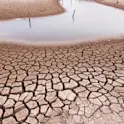Climate action
28 Jul 2022
Carbon removal using ‘blue carbon’ habitats ‘uncertain and unreliable’
By Cat Bartman / Media Centre, University of East Anglia Eelgrass beds are a form of Blue Carbon Restoring coastal vegetation – so called ‘blue carbon’ habitats – may not be the nature-based climate solution it is claimed to be, according to a new study. In their analysis researchers from the University of East Anglia (UEA), the French Centre National de la Recherche Scientifique (CNRS) and the OACIS initiative of the Prince Albert II of Monaco Foundation, challenge the widely held view that restoring areas such as mangroves, saltmarsh, and seagrass can remove large amounts of carbon dioxide (CO2) from the atmosphere. The findings of their review, published today in the journal Frontiers in Climate, identify seven reasons why carbon accounting for coastal ecosystems is not only extremely challenging but risky. These include the high variability in carbon burial rates, vulnerability to future climate change, and fluxes of methane and nitrous oxide. The authors, who also looked at information on restoration costs, warn that extra measurements can reduce these risks, but would mean much higher costs. However, they stress that blue carbon habitats should still be protected and, where possible, restored, as they have benefits for climate adaptation, coastal protection, […]












